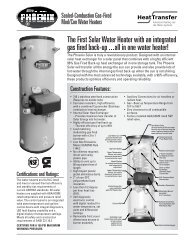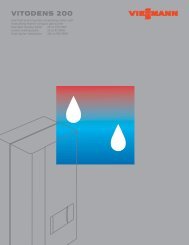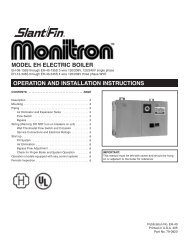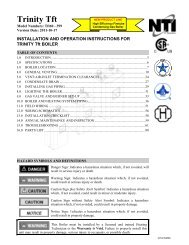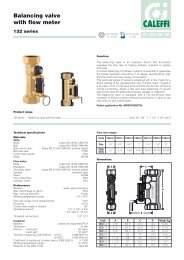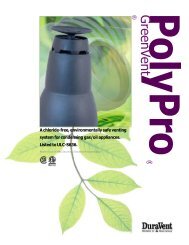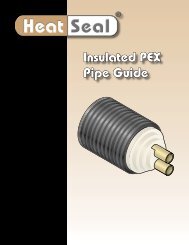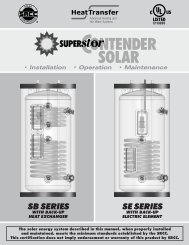<strong>Apricus</strong> <strong>Solar</strong> Collector <strong>Installation</strong> & <strong>Operation</strong> Manual - USA3.6. Stagnation <strong>and</strong> Overheating3.6.1. What is Stagnation?a) Stagnation: Stagnation refers to the condition that occurs whenever the pump stops running. This couldbe due to pump failure, power outage or most commonly, as the result of a max tank temperature protectionfeature setting on the controller. During stagnation, the collector, unable to actively dump heat, will continueto rise in temperature until the heat loss from the collector <strong>and</strong> piping equals the heat being absorbed. Instrong sunlight with high ambient temperatures, the collector will reach a peak stagnation temperatures ofabout 428°F (220°C), if dry (decommissioned system or drain-back), <strong>and</strong> a lower level of 320°F (160oC), ifthe piping <strong>and</strong> collectors contain fluid (as in pressurized systems).b) Consider High Temperatures: Components that may be exposed to the high temperatures such asvalves, plumbing or insulation should be suitably rated. Heat will not migrate downward to the tank becauseheat rises. but when the pump turns ON, a batch of super hot water may be delivered to the tank. Althoughthat will only last a minute or so, it should be considered when sourcing materials for the piping on thereturn line to tank.3.6.2. <strong>System</strong> Pressure & Boiling Temperaturea) Boiling Temperatures: The boiling temperature of water (or other fluid) is directly related to the pressureof the system. <strong>Water</strong> will boil at a higher temperature, the more pressure it under. This is a very importantconcept, as the pressure of the system can greatly influence the operation <strong>and</strong> reliability. Generally, a higherpressure is better (within reasonable limits).The table below provides pressures <strong>and</strong> corresponding boiling temperatures for water. These will beslightly higher for 50/50% glycol mixes, which on average have a boiling point of 220°F (104°C) at sea level(i.e.1 atmosphere of pressure) versus pure water at 212°F (100°C).PRESSURE <strong>and</strong> H2O BOILING POINTPSI oF kPaoC14.5 212 101 10028 247 203 12043.5 271 304 13358 289 405 14372.5 304 507 15187 317 608 158b) Different Fluids: In a closed loop system using a heat transfer fluid, the properties will be different thanplain water. The <strong>Solar</strong> Hi-temp heat transfer fluid manufactured by J.C.Whitlam does not boil until 468°F(242oC) at 1 Atmosphere <strong>and</strong> will never boil when used in an <strong>Apricus</strong> solar water heating system, as long aspressure above atmospheric is maintained. Other heat transfer fluids will behave in a similar fashion. Seethe section on heat transfer fluids for more information.c) Pressure Loss with Height: Even though a system might be a closed loop <strong>and</strong> pressurized, there isalways some pressure loss caused by height. This is extremely important to underst<strong>and</strong> when deciding thesystem pressure. The loss of pressure is about 0.5 psi per vertical foot. This means that while the pressureat the pump station may be 40 psi, a vertical rise of 50 ft will result in only 14.5 psi at the collector, which isthe same as atmospheric pressure. A low system pressure can result in bubbles (vapor) forming within theheat transfer fluid due to a lowered fluid boiling temperature. These bubbles will collect in the high points inthe solar loop piping, especially within the collector itself <strong>and</strong> can result in air locks that the pump may notbe able to overcome, resulting in no flow <strong>and</strong> then stagnation.During other periods of stagnation, the pressure in the system will rise, especially if there is any steamformation, but the same vertical loss still applies, so while the pressure may increase from 40 to 60 psi atthe pump station, the collector with a 40’ vertical height will only be about 40 psi.d) Flash Point: The flash point of a fluid is the lowest temperature at which vaporization can occur to form amixture in air that can be ignited. Propylene glycol has no measurable flash point in concentrations lessCopyright 2011 – <strong>Apricus</strong> Inc Doc: A7-05.4.1.4-PB-1.9 Page 22 of 126
<strong>Apricus</strong> <strong>Solar</strong> Collector <strong>Installation</strong> & <strong>Operation</strong> Manual - USAthan 80% <strong>and</strong> the flash point of J.C. Whitlam Hi-Temp is more than 50°F above the wet stagnationtemperature of the collector. For more information on heat transfer fluids see Section 3.31 <strong>and</strong> Apendix37-32.3.6.3. Correct <strong>System</strong> Sizing to Avoid Overheatinga) Avoid Excessive Heat Output: The system should be sized so that overheating of the tank is difficult toachieve in a single day, even during hot, sunny periods. If the system is over-sized, so that stagnationoccurs often during summer months, the system must be able to stagnate repeatedly without damage orheat transfer fluid degradation. Using stagnation as a daily means of dealing with an oversized system isNOT recommended.! Gradual loss of vacuum in evacuated tubes over time during normal use is not eligible for warranty claims.3.6.4. Heat DissipationFor systems designed for space heating that produce excessive summer heat output <strong>and</strong> use heat transferfluids, which cannot withst<strong>and</strong> high temperatures, a heat dissipation loop should be installed. <strong>Apricus</strong> offersHeat Dissipationkits specifically designed for this purpose. They can be installed above the pump station on the Return(Flow) Line. See section 9 for details.HD-25a) Fluid to Air: A finned fluid-to-air unit<strong>Solar</strong>canthermalbeinstallationsusedcantohavedissipateissues with excessiveheatheatfromproductionthein thesystem,summer months,onceparticuthetank hasreached the maximum temperature. <strong>Apricus</strong>systemoffersbeen larly if the has designedHD-25spaceforheating this well as hot water.the as purpose. for InThe to managetransfer fluid order heatheat in periods of high solar gain <strong>and</strong>energy usage, the heat needs to be safely dissipated. <strong>Apricus</strong>circulates through the copper pipe transferring excessiveprovides waterheatair a to heat exchangerreducedfically to a set ofspecilargeforaluminum<strong>Water</strong> this purpose. returning fins, from the solar which collector in turn dissipateheat to the surrounding air. Each HD-25 can becan directeddissipateHD-25 through an up to unit to5100 dissipateBtu/hr most, if not (1.5kW)heator all of the produced greater by anwith <strong>Apricus</strong>active 30 tube aircollector in full summer sun. This is achieved by using a solenoid or thermostatic 3 way valve. The HD-25flow. The HD-25 is for exterior installation may also only. be installed If greater in a circulation heat loop, pulling dissipation hot water from the is top required of the storage tank a fan <strong>and</strong> returning air h<strong>and</strong>lermidusedlevel, thus cooling the water. The amount of heat in the HD-25 is able to dissipate is depended on air flow,for space heating can be used.<strong>and</strong> the temperature differential between the hot water <strong>and</strong> ambient air.3-WayValveHD-25HD-25Physical SpecificationsOverall Height = 19.7”Overall Depth = 6.77”Overall Width = 14.7”Heat Transfer Area = 30.1 ft2Gross Weight = 14 lbMax Flow Rate = 3.96 US GpmIdeal Location = Good natural air flowLiquid = <strong>Water</strong> or Glycol - <strong>Water</strong> mixItemHD-25Dealer203.30MSRP308.00b) Underground Heat Dump Piping: An underground pipe run in copper or suitably temperature ratedplastic pipe can be completed. Any piping must be rated for direct burial in your area. Always call forappropriate locationsGlycoldigging. prior to If using copper, 100 ft of 1/2” pipe is required per 30 tube collector, or150 ft, if using synthetic pipe which has poorer heat transfer properties. If using a larger diameter pipe, ashorter length can be Today's used.engineered well Measuressolar collectorsmustcreate extremebetransfertakentemperatures.Legionellato avoid within the loop· duringWithst<strong>and</strong>sinactiveTemperatures up to 450periods <strong>and</strong>/or contamination of potable water sources.SOLAR HI-TEMP provides optimal heat transfer, while offering anti-freezeproperties for these dem<strong>and</strong>ing systems without the risk of environmentalIf possible bury the pipe contamination. at a depth that is normally moist as the water content of the soil will · helpBiodegradableheat dissipation.SOLAR HI-TEMP is a Nontoxic Heat Transfer Fluid <strong>and</strong> Anti-FreezeSolution with special anti-corrosion inhibitors, <strong>and</strong> color indicators, thatc) Alternative Heat provides Uses: heatDuringupthe356F transfer to summer, (180C) , freezeheat protection canto -15F also (-26C) be dumped into a hot-tub, jacuzzi, pool, large<strong>and</strong> burst protection to -50F (-46C).storage tank or underground thermal store.Heat Transfer Fluid <strong>and</strong> Anti-FreezeSolution for HVAC, Potable <strong>Water</strong>, <strong>and</strong> <strong>Solar</strong> <strong>System</strong>s.See also the followingSOLARpointHI-TEMP(3.6.5), regarding reduction of summer heat output.excellent in:Transfer FluidAnti-Freeze Solution worksHeat3.6.5. Adjusting Collector AngleClosedReduce to Back <strong>Solar</strong> <strong>System</strong>s· Overheating· Closed Loop <strong>Solar</strong> <strong>System</strong>sto improve· Hydronic HVAC <strong>System</strong>sa) Increase Angle to Reduce Summer Output: Apart from installing a smaller collector, a good method of· Potable <strong>Water</strong> Linesreducing summer heat output · Fire Sprinkler is to <strong>System</strong>s angle the collector for optimal winter absorption. This is achieved bySOLAR installing the collector at HI-TEMPangleTransfer-20° Anti-Freezethe latitude angle. dilution is necessary corresponds closely to theangle of the sun in maximum maintain heatthe during <strong>and</strong> freezethus transferwinter, The formula protection.maximizing provides an error freethe sky winter output.methodConversely, during the summersystem. SOLAR HI-TEMP Heat Transfer Fluid <strong>and</strong> Solution is suitable for use continuouswhen the sun is highthe to protect in operating the systems sky,withthe temperatures relativeto up surfaceAnti-Freezenotofdegrade 356F (180C), <strong>and</strong> will area the significantly collector fromwithshort term exposed to sunlight is reduced,exposures to temperatures up to 450F (232C).lowering overall heat production by about 20-25%. This option is ideal for installations that use solar thermalSOLAR HI-TEMP Heat Transfer Fluid <strong>and</strong> Anti-Freeze Solution is considered "Generally Recognized as Safe"by the Federal Food <strong>and</strong> Drug Administration. All Active solar energy systems installed should employ some–method of HeatIncdegrees F (232 degrees C)· Generally Recognized as Safe(GRAS)FullyCopyright 2011 <strong>Apricus</strong> Transfer Fluid <strong>and</strong> Anti-freeze Solution.A7-05.4.1.4-PB-1.9 Doc:Page 23 of 126· Easy, Ready Mixed Formula· Non-Toxic, Non CorrosiveItemHiTempDealer158.94MSRP219.22All Rights Reserved By S.U.N All Material is under copyright© Law by Listed CompaniesPage 18



